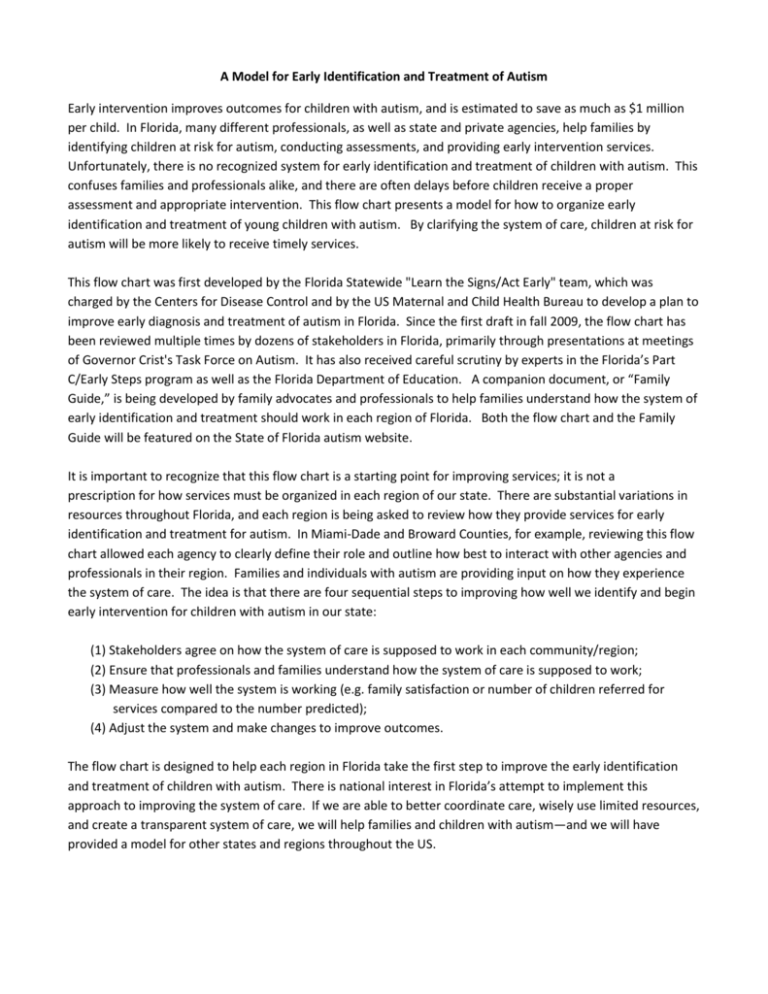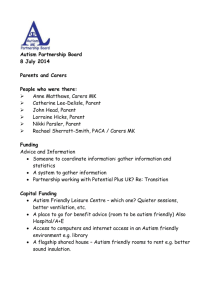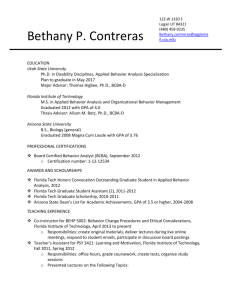ASD Flowchart Description - Association of Maternal & Child
advertisement

A Model for Early Identification and Treatment of Autism Early intervention improves outcomes for children with autism, and is estimated to save as much as $1 million per child. In Florida, many different professionals, as well as state and private agencies, help families by identifying children at risk for autism, conducting assessments, and providing early intervention services. Unfortunately, there is no recognized system for early identification and treatment of children with autism. This confuses families and professionals alike, and there are often delays before children receive a proper assessment and appropriate intervention. This flow chart presents a model for how to organize early identification and treatment of young children with autism. By clarifying the system of care, children at risk for autism will be more likely to receive timely services. This flow chart was first developed by the Florida Statewide "Learn the Signs/Act Early" team, which was charged by the Centers for Disease Control and by the US Maternal and Child Health Bureau to develop a plan to improve early diagnosis and treatment of autism in Florida. Since the first draft in fall 2009, the flow chart has been reviewed multiple times by dozens of stakeholders in Florida, primarily through presentations at meetings of Governor Crist's Task Force on Autism. It has also received careful scrutiny by experts in the Florida’s Part C/Early Steps program as well as the Florida Department of Education. A companion document, or “Family Guide,” is being developed by family advocates and professionals to help families understand how the system of early identification and treatment should work in each region of Florida. Both the flow chart and the Family Guide will be featured on the State of Florida autism website. It is important to recognize that this flow chart is a starting point for improving services; it is not a prescription for how services must be organized in each region of our state. There are substantial variations in resources throughout Florida, and each region is being asked to review how they provide services for early identification and treatment for autism. In Miami-Dade and Broward Counties, for example, reviewing this flow chart allowed each agency to clearly define their role and outline how best to interact with other agencies and professionals in their region. Families and individuals with autism are providing input on how they experience the system of care. The idea is that there are four sequential steps to improving how well we identify and begin early intervention for children with autism in our state: (1) Stakeholders agree on how the system of care is supposed to work in each community/region; (2) Ensure that professionals and families understand how the system of care is supposed to work; (3) Measure how well the system is working (e.g. family satisfaction or number of children referred for services compared to the number predicted); (4) Adjust the system and make changes to improve outcomes. The flow chart is designed to help each region in Florida take the first step to improve the early identification and treatment of children with autism. There is national interest in Florida’s attempt to implement this approach to improving the system of care. If we are able to better coordinate care, wisely use limited resources, and create a transparent system of care, we will help families and children with autism—and we will have provided a model for other states and regions throughout the US.






